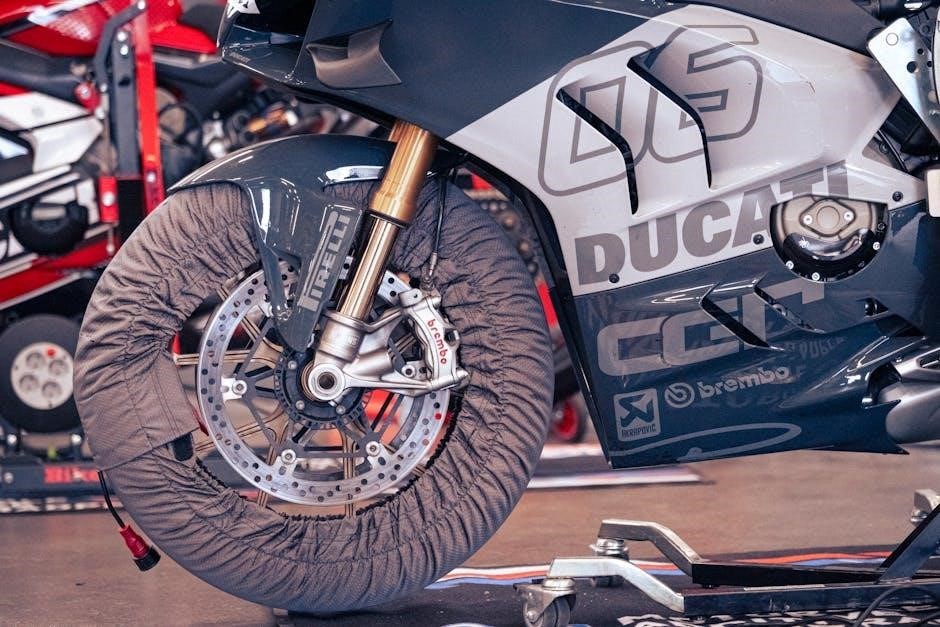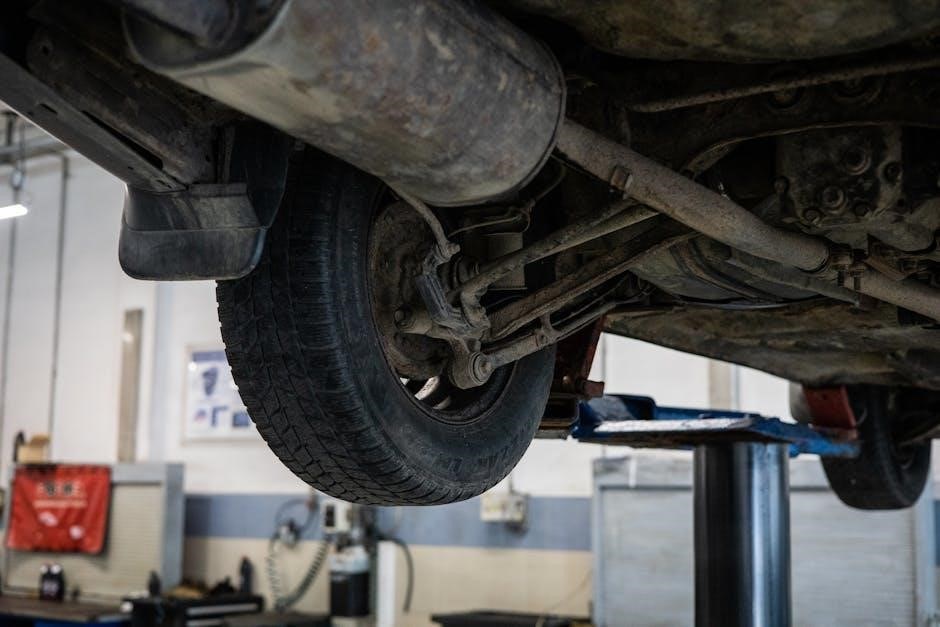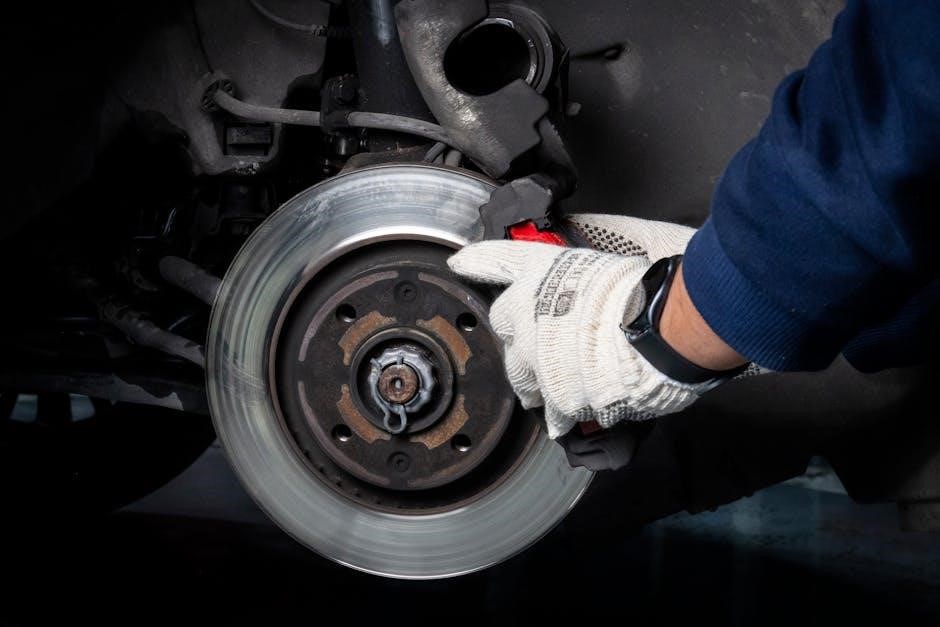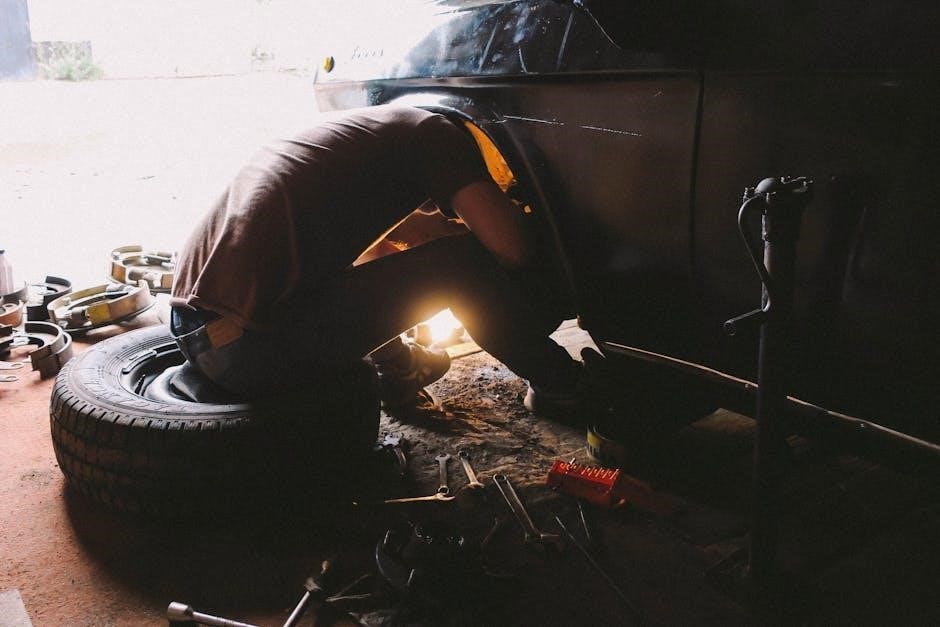This manual provides a comprehensive guide for maintaining Cleveland Wheels and Brakes‚ ensuring safety and optimal performance. It covers essential procedures‚ troubleshooting‚ and compliance standards for aircraft braking systems.
1.1 Overview of Cleveland Wheels and Brakes
Cleveland Wheels and Brakes is a leading provider of aircraft braking systems‚ offering high-quality components such as wheels‚ brakes‚ and hydraulic systems. Their products are designed for durability‚ safety‚ and optimal performance in various aircraft applications. The service manual serves as a critical resource for maintenance technicians‚ detailing procedures for inspection‚ lubrication‚ and replacement of parts. Cleveland emphasizes the use of genuine components to maintain warranty validity and ensure reliability. Supplementary publications‚ like the Component Maintenance Manual (AWBCMM0001)‚ provide additional guidance for technicians. These resources collectively support the proper servicing of Cleveland Wheels and Brakes systems.
1.2 Purpose of the Service Manual
The Cleveland Wheels and Brakes Service Manual is designed to provide maintenance technicians with detailed procedures for inspecting‚ servicing‚ and repairing aircraft braking systems. Its primary objective is to ensure safety‚ reliability‚ and optimal performance of Cleveland components. The manual serves as a supplementary guide to specific aircraft maintenance requirements‚ offering step-by-step instructions for tasks such as brake pad replacement‚ hydraulic system servicing‚ and wheel overhauls. By adhering to the manual’s guidelines‚ technicians can maintain compliance with warranty conditions and ensure the longevity of Cleveland Wheels and Brakes systems.
1.3 Key Features of the Service Manual
The service manual includes detailed inspection guidelines‚ lubrication procedures‚ and replacement steps for brake pads. It offers comprehensive overhaul techniques for wheels and brake discs‚ along with methods for diagnosing hydraulic leaks. Additional resources such as torque specifications and part numbering systems are provided‚ ensuring compliance with safety standards and warranty requirements. The manual is structured to assist technicians in performing efficient and accurate maintenance‚ thereby enhancing the overall performance and longevity of Cleveland Wheels and Brakes components.

Understanding Cleveland Wheels and Brakes Components
This section introduces the fundamental components of Cleveland Wheels and Brakes‚ including wheel assemblies‚ brake systems‚ and hydraulic parts‚ essential for aircraft braking functionality and safety.
2.1 Wheel Assemblies and Their Functions
Cleveland wheel assemblies are designed for durability and reliability‚ featuring components like hubs‚ bearings‚ and rims. They support aircraft weight‚ enable smooth taxiing‚ takeoff‚ and landing‚ and provide secure attachment points for brake systems. Constructed from high-strength materials such as aluminum alloys‚ they ensure resistance to wear and corrosion. Proper installation and maintenance‚ as outlined in the Component Maintenance Manual AWBCMM0001‚ are crucial for optimal performance and safety. Using genuine Cleveland parts ensures compliance with warranty terms and guarantees reliability in critical aircraft operations.
2.2 Brake Systems and Their Components
Cleveland brake systems are engineered for reliable and consistent performance‚ ensuring safe aircraft operations. Key components include brake calipers‚ discs‚ pads‚ and master cylinders. The calipers house the brake pistons‚ which apply friction to the discs when activated. Brake pads are constructed from durable‚ heat-resistant materials to withstand repeated use. Hydraulic systems power the brakes‚ providing precise control during landing and taxiing. Regular inspection and maintenance‚ as detailed in the Component Maintenance Manual AWBCMM0001‚ are essential to prevent wear and ensure optimal braking efficiency. Proper servicing guarantees compliance with safety standards and extends component lifespan.
2.3 Hydraulic Components and Their Roles
The hydraulic system in Cleveland Wheels and Brakes is critical for transmitting brake actuation forces. Key components include master cylinders‚ slave cylinders‚ hydraulic lines‚ and reservoirs. Master cylinders convert non-hydraulic pressure into hydraulic pressure‚ while slave cylinders translate this pressure into mechanical energy to engage brakes. Hydraulic lines ensure fluid flow‚ and reservoirs maintain adequate fluid levels. Proper maintenance‚ as outlined in the Component Maintenance Manual AWBCMM0001‚ is essential to prevent leaks and ensure reliable braking performance. Regular inspection of hydraulic components guarantees system integrity and optimal functionality‚ aligning with safety and operational standards.

Maintenance Procedures for Cleveland Wheels and Brakes
This manual outlines essential maintenance procedures for Cleveland Wheels and Brakes‚ ensuring safety and efficiency. It covers routine inspections‚ lubrication‚ and brake pad replacements‚ emphasizing adherence to guidelines for optimal performance and longevity.
3.1 Routine Inspection Guidelines
Regular inspections are crucial for ensuring the integrity of Cleveland Wheels and Brakes. Start by visually examining brake pads for wear‚ ensuring they meet minimum thickness specifications. Check hydraulic lines for leaks or damage‚ and inspect wheel bearings for smooth operation. Verify that all bolts and nuts are properly torqued to specifications. Use a torque wrench to ensure accuracy. Additionally‚ inspect the brake rotor for excessive wear or warping. Always refer to the Component Maintenance Manual (AWBCMM0001) for detailed inspection procedures and guidelines. Regular inspections help prevent potential issues and ensure optimal braking performance and safety.
3.2 Lubrication and Grease Packing Procedures
Proper lubrication is essential for maintaining Cleveland Wheels and Brakes. Use Cleveland-approved grease‚ applying a thin‚ even layer to all moving parts. Refer to the Component Maintenance Manual (AWBCMM0001) for specific grease specifications and application guidelines. Ensure all pivot points and bearings are thoroughly lubricated. Avoid over-greasing‚ as it can attract debris and reduce efficiency. Regular lubrication helps prevent corrosion and ensures smooth operation. Always follow torque specifications for bolts and nuts to maintain system integrity. Proper grease packing extends component life and ensures optimal braking performance.
3.3 Brake Pad Replacement Steps
Replace brake pads when wear exceeds 1/8 inch or shows uneven wear. Begin by removing the wheel and caliper‚ taking care not to damage the brake hose. Use approved tools to compress the caliper and remove old pads. Inspect the rotor for damage or excessive wear. Clean the caliper and rotor with a lint-free cloth. Install new pads‚ ensuring proper alignment and securement. Reassemble the caliper‚ tighten bolts to specified torque‚ and replace the wheel. Test the brakes by applying gentle pressure and increasing gradually to ensure proper function. Refer to the Component Maintenance Manual (AWBCMM0001) for detailed instructions.

Overhaul and Repair of Cleveland Wheels and Brakes
Inspect components for wear or damage. Replace worn or damaged parts‚ resurface rotors if necessary‚ and ensure proper alignment. Use genuine Cleveland parts for reliability and safety.
4.1 Wheel Overhaul Procedures
Begin by disassembling the wheel assembly‚ removing hardware and bearings. Inspect for wear or damage. Replace worn or corroded components‚ ensuring all parts meet Cleveland specifications. Lubricate moving parts with approved grease. Reassemble the wheel‚ tightening bolts to specified torque values. Test the wheel for proper rotation and alignment. Use genuine Cleveland parts to maintain warranty and performance. Refer to the Component Maintenance Manual (AWBCMM0001) for detailed steps and torque specifications. Proper reassembly ensures optimal braking efficiency and safety. Always follow manual guidelines to avoid system malfunctions or warranty voidance.
4.2 Brake Disc Replacement Techniques
Begin by inspecting the brake disc for excessive wear‚ warping‚ or scoring. Remove the disc from the wheel hub‚ ensuring proper alignment. Clean the hub and surrounding area to prevent contamination. Install the new disc‚ securing it with approved fasteners. Tighten bolts to the specified torque using a torque wrench. Apply a thin layer of approved grease to moving parts. Reassemble the brake system‚ ensuring proper alignment of components. Test the brakes by applying gentle pressure and checking for even wear. Refer to torque specifications in the Component Maintenance Manual (AWBCMM0001) for accuracy. Use genuine Cleveland parts to maintain warranty and performance. Proper installation ensures optimal braking efficiency and safety.
4.3 Hydraulic System Servicing
Hydraulic system servicing is critical for maintaining optimal brake performance. Begin by draining the old fluid and flushing the system to remove contaminants. Inspect all hydraulic lines and components for damage or leaks. Replace worn or damaged parts with genuine Cleveland components. Refill the system with the recommended hydraulic fluid‚ ensuring no air enters the lines. Bleed the system thoroughly to eliminate air bubbles. Check the reservoir level and test the brakes for proper function. Refer to the Component Maintenance Manual (AWBCMM0001) for detailed procedures and torque specifications. Regular servicing prevents hydraulic failure and ensures reliable braking performance. Use only approved fluids and components to maintain system integrity and warranty validity.

Troubleshooting Common Issues
Identify brake pad wear‚ diagnose hydraulic leaks‚ and address uneven wear. Refer to the service manual for detailed solutions and ensure proper system alignment for optimal performance.
5.1 Identifying Wear and Tear on Brake Pads
Regular inspection of brake pads is crucial for maintaining aircraft safety. Visually inspect pads for excessive wear‚ uneven thinning‚ or cracking. Measure pad thickness using a micrometer; replace pads if they fall below the minimum allowable thickness specified in the service manual. Look for signs of overheating‚ such as discoloration or glazing. Ensure proper alignment to prevent uneven wear. Refer to Section 9.1 for detailed procedures and torque specifications. Addressing wear promptly prevents costly repairs and ensures optimal braking performance.
5.2 Diagnosing Hydraulic System Leaks
To diagnose hydraulic system leaks‚ begin with a visual inspection of hydraulic lines‚ connections‚ and components for signs of damage‚ cracks‚ or fluid residue. Use a pressure test kit to pressurize the system and identify leaks. Inspect brake cylinders‚ valves‚ and seals for any fluid seepage or drips. Refer to the Component Maintenance Manual (AWBCMM0001) for specific procedures. Addressing leaks promptly is critical to maintaining system integrity and ensuring safe aircraft operation. Always follow proper safety protocols when working with pressurized hydraulic systems.
5.3 Addressing Uneven Brake Wear
Uneven brake wear can lead to reduced braking efficiency and safety risks. Inspect brake pads and rotors for uneven wear patterns. Check alignment of brake components and ensure proper installation. Refer to the Component Maintenance Manual (AWBCMM0001) for alignment procedures. Clean and lubricate moving parts as specified. Replace worn or damaged components promptly. Ensure all hydraulic connections are secure and free from leaks. Addressing uneven wear early prevents further damage and maintains optimal braking performance. Always follow Cleveland Wheels and Brakes guidelines for repair and maintenance.
Installation and Alignment Guidelines
Proper installation and alignment of Cleveland wheels and brakes are crucial for safety and performance. Follow torque specifications and alignment procedures outlined in the service manual.
6.1 Proper Wheel Installation Techniques
Proper installation of Cleveland wheels ensures safety and optimal performance. Start by applying the recommended grease to the axle and wheel bearings. Tighten the axle nut to the specified torque using a torque wrench. Ensure the wheel is securely fastened to the hub assembly without over-tightening. Refer to the Component Maintenance Manual (AWBCMM0001) for detailed torque specifications. After installation‚ inspect the wheel for proper alignment and perform a test roll without brakes to ensure smooth operation. Finally‚ apply the brakes gently to check for even engagement and proper function.
6.2 Brake System Alignment Procedures
Proper alignment of the brake system is crucial for optimal performance and safety. Begin by ensuring the brake calipers are correctly positioned over the brake discs. Use a dial indicator to measure and adjust the alignment of the brake assembly. Tighten the mounting bolts in a star pattern to the specified torque‚ as outlined in the Component Maintenance Manual (AWBCMM0001). After tightening‚ perform a test roll without applying the brakes to ensure smooth operation. Finally‚ apply the brakes gently and check for even wear and proper alignment. Misalignment can lead to uneven wear and reduced braking efficiency‚ so regular checks are essential.
6.3 Ensuring Proper Hydraulic System Alignment
Proper hydraulic system alignment is critical for efficient braking performance. Begin by inspecting all hydraulic connections and lines for damage or leaks. Use a torque wrench to secure all fittings to the specified torque values outlined in the Component Maintenance Manual (AWBCMM0001). Align the hydraulic components with the brake calipers‚ ensuring proper clearance and orientation. Bleed the hydraulic system to remove air bubbles‚ which can cause spongy brake feel. Finally‚ test the system under normal operating conditions to ensure consistent pressure and response. Misalignment or improper torque can lead to fluid leaks or component failure‚ compromising safety and performance.

Compliance and Certification
Compliance with Cleveland Wheels and Brakes standards ensures safety and performance. Always use genuine parts and follow manual guidelines to maintain warranty validity and system integrity.
7.1 Importance of Using Genuine Cleveland Parts
Using genuine Cleveland parts ensures safety‚ quality‚ and performance. They are specifically designed for Cleveland systems‚ guaranteeing proper fitment and functionality. Non-genuine components can void warranties and compromise safety standards. Genuine parts maintain system integrity and compliance with certification requirements. Always prioritize authentic Cleveland components to uphold aircraft braking system reliability and adhere to manufacturer guidelines.
7.2 Warranty Considerations for Cleveland Components
Using non-genuine Cleveland parts voids the warranty‚ as only authentic components ensure compliance with safety and performance standards. The warranty covers defects in materials and workmanship for genuine parts. Proper installation and adherence to service manual instructions are essential to maintain warranty validity. Any unauthorized modifications or use of third-party components may result in warranty termination. Always verify part authenticity to ensure full warranty coverage and system reliability.
7.3 Adherence to Service Manual Instructions
Strict adherence to the Cleveland Wheels and Brakes Service Manual is crucial for ensuring safety‚ performance‚ and compliance with warranty terms. Proper installation‚ maintenance‚ and inspection procedures must be followed to avoid voiding the warranty. Unauthorized modifications or deviations from specified guidelines can lead to system malfunctions and potential safety risks. Always refer to the latest issue of the manual for accurate and detailed instructions. Non-compliance may result in voiding the warranty and compromising the reliability of the brake and wheel systems.

Operational Tips and Techniques
Proper wheel alignment‚ regular brake inspections‚ and avoiding excessive heat are key. Follow manual guidelines to ensure optimal performance and longevity of components.
8.1 Best Practices for Brake System Maintenance
Regular inspections of brake pads‚ discs‚ and hydraulic components are crucial. Clean and lubricate parts as specified to prevent wear and tear. Always adhere to torque specifications and use genuine Cleveland parts to ensure safety and performance. Proper grease packing and alignment techniques can significantly extend component lifespan. Avoid overheating brakes by moderating use during descent. Routine checks for fluid leaks and worn pads help maintain optimal braking efficiency. Follow the service manual’s guidelines for consistent and reliable aircraft operation.
8.2 Avoiding Common Maintenance Mistakes
Common mistakes include using non-Cleveland parts‚ which voids warranties‚ and improper lubrication of components. Overlooking hydraulic system leaks can lead to system failure. Avoid excessive heating of brakes‚ as this damages discs and pads. Never skip routine inspections‚ as worn pads or misaligned brakes can compromise safety. Ensure all torque specifications are followed precisely. Referencing the Component Maintenance Manual (AWBCMM0001) helps avoid errors. Proper grease packing and alignment techniques are critical. Always verify part compatibility before installation to maintain system integrity and performance. Following these guidelines ensures reliable and safe aircraft braking systems. Proper adherence to manual instructions is essential.
8.3 Optimizing Brake Performance
Optimizing brake performance involves using genuine Cleveland parts‚ ensuring proper lubrication‚ and avoiding overheating. Regular inspections and timely replacement of worn components are crucial. Maintain correct hydraulic fluid levels and ensure alignment is precise. Avoid aggressive braking to prevent disc warping. Refer to the Component Maintenance Manual (AWBCMM0001) for grease recommendations. Proper torque specifications must be followed for all components. Regular servicing and adherence to manual guidelines ensure consistent and reliable braking. Always inspect for leaks and wear during routine checks to maintain optimal performance and safety. Proper maintenance extends component life and ensures efficient braking systems. Follow all safety protocols for best results.

References and Additional Resources
- Component Maintenance Manual (AWBCMM0001)
- Supplementary Technical Publications
- Service Bulletins and Updates
- Kit Documents
- Product Exploded View
- Product Reference Memo
- Supplemental Type Certificate
9.1 Component Maintenance Manual (AWBCMM0001)
The Component Maintenance Manual (AWBCMM0001) is a critical resource for maintaining Cleveland Wheels and Brakes. It provides detailed procedures for overhaul‚ inspection‚ and repair of components. The manual covers lubrication guidelines‚ grease packing‚ and replacement steps for parts like brake pads and discs. It also includes torque specifications and alignment techniques. Referencing this manual ensures compliance with Cleveland’s standards‚ optimizing performance and safety. Technicians rely on AWBCMM0001 for accurate‚ step-by-step instructions tailored to external design wheels and brakes. Adhering to its guidelines is essential for maintaining warranty validity and system integrity.
9.2 Supplementary Technical Publications
Supplementary technical publications complement the Cleveland Wheels and Brakes Service Manual‚ offering additional insights and detailed instructions. These resources include service bulletins‚ product reference memos‚ and exploded-view diagrams. They provide updated information on specific components‚ troubleshooting techniques‚ and new maintenance practices. Technicians can access these publications through Cleveland’s official website or authorized distributors. Supplementary materials ensure that maintenance procedures are current and aligned with industry standards‚ enhancing the overall effectiveness of servicing Cleveland Wheels and Brakes systems. They are invaluable for addressing complex or less common maintenance scenarios.
9.3 Service Bulletins and Updates
Service bulletins and updates from Cleveland Wheels and Brakes provide critical information on product improvements‚ safety notices‚ and technical advisories. These documents are periodically released to address specific issues‚ enhance performance‚ or introduce new maintenance procedures. They often include mandatory actions to ensure compliance with safety regulations. Technicians must review these bulletins regularly to stay informed about the latest developments and updates. By adhering to these guidelines‚ maintenance personnel can ensure the reliability and safety of Cleveland Wheels and Brakes systems. Regular updates help in preventing potential issues and optimizing system performance.

Frequently Asked Questions
Common inquiries include troubleshooting brake alignment‚ obtaining free inspections‚ and understanding service costs. These questions are addressed with practical solutions and resource guidance.
10.1 How to Determine If Brake Alignment Is Needed
To determine if brake alignment is needed‚ inspect for uneven wear on brake pads or discs. Perform a test ride without using the rear brake; if stopping feels uneven‚ alignment may be necessary. Visually check for misaligned brake components or excessive wear patterns. After riding‚ touch the brake discs; excessive heat could indicate misalignment. Consult the service manual for detailed inspection procedures and alignment checks to ensure optimal braking performance and safety. Proper alignment prevents premature wear and maintains efficient braking systems.
10.2 How to Obtain a Free Alignment Check
To obtain a free alignment check‚ contact an authorized Cleveland Wheels and Brakes service center or refer to the service manual for recommended providers. Many dealerships offer complimentary checks as part of routine maintenance services. Visit the Cleveland Wheels and Brakes website for a list of certified service centers near you. Additionally‚ some tire and brake service providers‚ like Tire Discounters‚ may offer free alignment checks upon request. Ensure to verify the service center’s certification to maintain warranty compliance and receive accurate assessments for your aircraft’s braking system.
10.3 Cost of Alignment Services
The cost of alignment services for Cleveland Wheels and Brakes varies depending on the service provider and location. Authorized dealerships and specialized centers like Tire Discounters or Lakewood Firestone Tire Pros typically offer competitive pricing. Expect to pay between $50 to $150 for standard alignment checks‚ with potentially higher costs for advanced adjustments or additional repairs. Some providers may include free alignment checks as part of routine maintenance packages. Always verify pricing with the service center and ensure they use genuine Cleveland parts to maintain warranty compliance. Checking with multiple providers can help find the best value for your needs.
The Cleveland Wheels and Brakes Service Manual ensures optimal performance and safety through detailed maintenance‚ repair‚ and compliance guidelines‚ essential for aircraft braking systems.
11.1 Summary of Key Maintenance Practices
Regular inspections‚ proper lubrication‚ and timely replacement of worn components are critical for optimal performance. Adhering to the service manual ensures compliance and safety. Routine checks include brake pad wear‚ hydraulic fluid levels‚ and wheel bearings. Lubrication procedures‚ such as grease packing‚ prevent corrosion and wear. Replacing brake pads and discs when worn ensures reliable braking. Using genuine Cleveland parts maintains warranty validity and performance. Following these practices extends component life‚ enhances safety‚ and ensures aircraft readiness. Consistent servicing aligns with manufacturer guidelines‚ preventing costly repairs and downtime.
11;2 Importance of Regular Servicing
Regular servicing is essential for ensuring the safety‚ reliability‚ and optimal performance of Cleveland Wheels and Brakes. It helps identify and address wear and tear early‚ preventing potential failures. Routine inspections‚ lubrication‚ and part replacements maintain system integrity. Neglecting servicing can lead to brake failure‚ compromised safety‚ and increased maintenance costs. Adhering to the service manual’s guidelines ensures compliance with safety standards and extends the lifespan of components. Regular servicing also maintains warranty validity and ensures aircraft operational readiness‚ making it a critical aspect of aircraft maintenance.
11.3 Final Tips for Optimal Performance
To achieve optimal performance from Cleveland Wheels and Brakes‚ always use genuine parts and adhere to torque specifications. Avoid mixing components from different manufacturers‚ as this can void warranties and compromise safety. Regularly inspect brake pads and discs for wear‚ and ensure proper alignment during installation. Lubricate moving parts as specified to prevent corrosion and friction. After servicing‚ conduct a test flight to verify system functionality. Following these guidelines ensures reliability‚ safety‚ and extended component lifespan. Proper adherence to the service manual guarantees peak performance and compliance with industry standards.

Appendices
This section provides supplementary information‚ including part numbering systems‚ torque specifications‚ and recommended grease for Cleveland Wheels and Brakes components‚ ensuring accurate maintenance practices.
12.1 Part Numbering System Explained
Cleveland Wheels and Brakes utilizes a structured part numbering system to identify components. The long-form method uses an eight-digit code‚ while the short form employs an alpha-numeric sequence. Both systems help technicians quickly locate and verify parts‚ ensuring accuracy during maintenance. The long-form code includes sections for category‚ subtype‚ and serial number‚ while the short form uses letters and numbers to denote specific attributes. This standardized approach prevents confusion and ensures compatibility‚ making it easier to reference parts in the Component Maintenance Manual (AWBCMM0001) or other supplementary documents.
12.2 Torque Specifications for Brake Components
Torque specifications for Cleveland Wheels and Brakes components are critical for ensuring proper installation and safety. The service manual provides detailed torque values for brake discs‚ rotors‚ and other hardware to prevent over-tightening or under-tightening. Adhering to these specifications is essential to maintain system integrity and avoid potential failure. Always use a calibrated torque wrench and refer to the Component Maintenance Manual (AWBCMM0001) for precise values. Failure to follow these guidelines may result in compromised performance or warranty voidance. Proper torque ensures optimal braking efficiency and longevity of the components.
12.3 Recommended Grease for Cleveland Components
The Cleveland Wheels and Brakes service manual specifies the use of lithium-based or synthetic grease for optimal performance. These greases are designed to withstand high temperatures and ensure smooth operation of wheel bearings and brake components. Proper grease application is critical to prevent corrosion and wear. Refer to the Component Maintenance Manual (AWBCMM0001) for detailed grease specifications. Using non-approved greases may void the warranty and compromise system reliability. Always follow the manual’s guidelines for grease packing procedures to maintain safety and efficiency. Proper lubrication ensures longevity and optimal functionality of Cleveland components. Adherence to these standards is essential for maintaining aircraft safety and performance.
